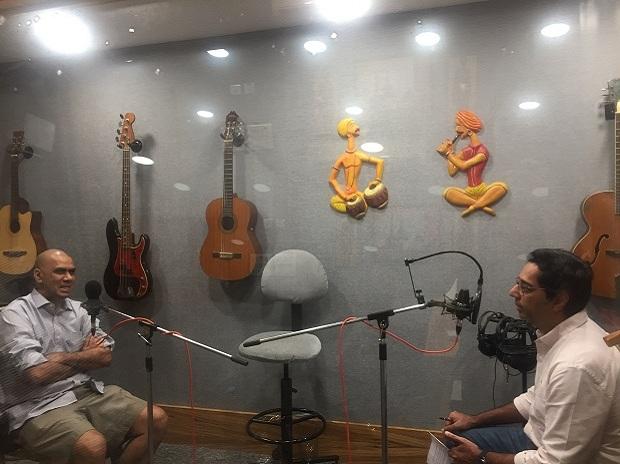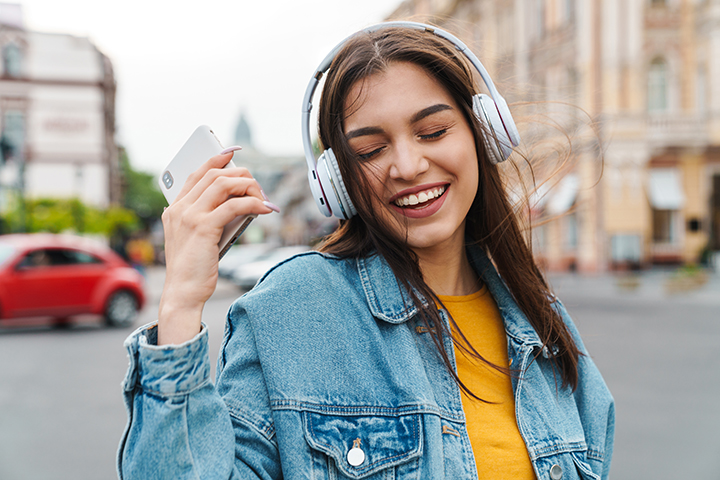Podcasts are a great way for listeners to discover the content they want to hear. They’re downloadable so you can listen to them whenever, wherever and however you want
If you think you know nothing about the world of podcasts, you may stand corrected. You may have heard many unwittingly and, in fact, Mann Ki Baat is the most popular in India, the world’s third-largest podcast-listening market, after China and the US.
Podcast listening is growing in the country, and whether you’re driving, cooking, exercising, or doing household chores, with podcasts there’s an opportunity to use that time to listen to a riveting story, catch up on the news, get in a laugh, or learn something new.
The year 2020 has been remarkable for podcasts. Says a spokesperson from Spotify: “While Spotify has been present in India since 2019, some of our listeners explored their first podcast this year. Over the past year, Indian listeners have been consuming lifestyle-based content with society and culture being among the most popular genres. Other genres that are doing well include comedy, lifestyle and health, education, art and entertainment and news.”
Some interesting trends in Spotify’s 2020 data for India show that Originals & Exclusives (O&E) shine with the top 10 most-streamed episodes consisting of Maha Bharat with Dhruv Rathee, Bhaskar Bose, The Michelle Obama Podcast, and The Big Fat Indian Ghotala. In terms of listening among genders, the Spotify survey found higher growth in the percentage of female listeners who tuned in this year. Self-help and motivation had a lot of traction. The Ranveer Show, Gita for the Young & Restless and Ted Talks Daily went up the charts. Additionally, India went beyond English and Hindi to create and upload content in languages such as Spanish, Portuguese, Indonesian, German, and Japanese.
Podcast listening has increased markedly in India in the past few years. Says Sreeraman Thiagarajan, CEO, aawaz.com: “Podcast listening has increased by 57.6 per cent in India, with monthly listeners surging from 25.4 million in 2017 to 40 million by 2018-end. Growth is set to continue over the forecast period with listener numbers set to rise at a 34.5 per cent CAGR to 176.1 million by 2023, as per data from Entertainment & Media, PwC India.” Take the case of aawaz.com which has packed in over 800 hours of original programming in Hindi and Indian-English across 20 genres, 170 shows, and 5,800-plus episodes since its launch in 2019. This shows the potential of the podcasting industry in India, says Thiagarajan.
The who, why and where of podcast
Anybody can make a podcast, be it independent podcasters or institutional channels. The former is any individual who is passionate about a topic, while the latter includes companies like aawaz creating audio experiences such as stories, conversational masterclass, and more. Like they say, ‘podcast is the new blog’.
Individuals and companies are increasingly opting for podcast over other media. Take the case of designer sister duo Sujata and Taniya Biswas, who recently launched ‘Musings of Suta’ an exclusive saree podcast that features everything a saree lover would want to know. Recorded through Hubhopper’s online studio, the podcast has the sister duo talk about their love for the garment and their childhood memories around it, the significance of sarees during Indian festivities, the urban versus rural India’s interpretation of sarees, love for the garment and age being no barrier for wearing one.
They invested close to Rs one lakh to launch their podcast. Says Sujata, “Podcasts have given us multifold RoI. In terms of investment in different platforms, each has its own set of KPIs to measure the RoI. We ventured into podcasts only to reach a wider audience and connect with as many people as possible. Sales was never our motive. With a podcast, you can define your target audience, which helps understand customer feedback better. It is the difference between a movie and a web series, radio being the movie.” They got a lot of messages on social media from customers asking them about their lives, how they started the business and developed a “personal connect”.
A large difference between podcasting and live radio is that the latter cannot be edited once broadcast, whereas podcasts are pre-recorded so they can easily be adjusted after recording. While radio can include pre-recorded content, many shows are usually live broadcasts. Says Taniya, “Radio as a medium has a much shorter shelf life than a podcast. You can listen to a podcast anytime and you don’t face connectivity issues unlike Radio. Podcast is like documenting your stories. Also, people wait for the next episodes, they are curious to know what’s next! It is addictive if the story line is great. Besides, once you’re done with a couple of episodes you can do a little bit of groundwork on what your audiences liked and what they didn’t, and other research work that will help you understand and take decisions for other episodes.”
What is the ideal duration for a podcast? The ideal episode length is determined by content. If your episode contains a solid 20 minutes of good content that delivers on its title and serves your audience, then 20 minutes is the perfect length. People have a short attention span. Each episode ideally shouldn’t cross more than 15-20 minutes. But there is no time limit as such.
Where Podcasts? The idea should be to reach out and publish your content on as many platforms as possible. You never know what will push your podcast to different heights. Some of the top platforms are iTunes/Apple Podcasts, Spotify, Google Podcasts, Stitcher, TuneIn.

Credit: aawaz.com, Host, entrepreneur and Mumbai lover Ajay Menon (right) recording a podcast about various facets of the city with journalist Naresh Fernandes.
How podcasts stand out in the world of voice
They are more dynamic than radio and audio books. In fact, audio books are more like straight readings of an existing physical or e-book, or any book written for audio. Says Arcopol Chaudhuri, Rights & Backlist Manager, HarperCollins India: “Podcasts are a lot more dynamic — they’re like talk shows, documentaries, with music, more editing, more chatty in nature, featuring often multiple voices and without a script to read from. There may be a basic outline, but nobody is reading what they’re saying.” Ninety-nine per cent of audiobooks don’t have music or any form of dramatisation. Basically, if you’re too lazy to ‘read’ a paperback or hard cover, the audio book is a format where the reading is being done for you by a narrator.
Importantly, podcasts are still free and have sponsored content (ads) in them, but audiobooks aren’t free. They have a fixed MRP, like any book.
What makes radio different from a podcast? While the latter are broadcast with the help of the internet, radio works by transmitting electromagnetic waves. Says Omkar Pawaskar, Creative Head, Kuku FM: “Radio shows have fixed time slots, duration, and decided formats for the shows. But in podcasts, there is flexibility in terms of duration, frequency, and format. It is possible for someone who produces podcasts to publish his content weekly, fortnightly, or monthly. Podcasts range from a three-minute snippet to a three-hour-long documentary.”
Content and creative liberty are other distinguishing factors in a podcast. The content is more focussed. A podcast can be news-based or could have fictional stories of human interest. The length of a podcast cannot be pre-determined. There can be seasons for the podcasts just like a television programme, or it can just be episodic audios that may last for months. In radio, one cannot enjoy several genres in their entirety. Radio shows can have segments for parody or comedy. But, a podcast can be entirely based on a single genre.
Podcasts enjoy more creative liberty, giving space to issues that cannot be aired on radio, says Pawaskar. An entire podcast series can be dedicated to a particular issue but in radio, it becomes difficult owing to the restriction of time and diverse audiences. A radio production team has to keep its audience updated about traffic news and mould opinions as per the ongoing local socio-political scenario. The content serves the audiences within a fixed geography. But making of a radio show content undergoes many stages and approvals. It might so happen that the production team may reject an idea from the creative team but in a podcast, the podcaster owns the product. So, he has full control, from choosing the topic to writing and presenting the content.
Training to be a podcaster
Spoken-word podcasts are similar to good writing, and fictional podcasts are similar to storytelling. The only difference is that podcasts are strictly audio.
Thiagarajan of aawaz.com points out a few best practices to keep in mind for a good podcast. Firstly, have an opinion or a keep angle–your listeners are looking forward to your perspective on a given topic. Second, do not rant–there’s a thin line between being vocal about a subject you are passionate about and ranting about it. Sonologue.com offers courses in podcasting.
Finally, the biggest advantage that a podcast listener enjoys is that s/he can download and save it, and listen to it anytime, anywhere, and any number of times–Unlike in radio, which is transient, once done then gone.
Subscription Charges
Podcasts generally charge for premium content, much like the OTT platforms and they have variable plans. Take the case of Spotify which is free for regular content but charges a Premium for individual users 119 per month who pay through recurring credit or debit cards; Rs 129 per month to Rs 1,189 annually for those who pay through e-wallets and other debit or credit card. Student plan is Rs 59-66 per month; Premium Family Plan is priced at Rs 179 per month, and allows up to 6 users on one account while premium duo plan costs Rs 149 per month and is a plan is for two people living at the same home address, where each individual gets their own individual premium account. See table: Podcast services and prices for further details.
Table: Podcast services and prices
| Name | Subscription charges (annual or monthly) for listeners | Paid Services |
|
Apple Podcasts |
No fees for podcast but subscription needed/Premium Services may vary | Subscription and app needed |
| Spotify | Free as well as paid, 119 Rs/Per Month for Individuals which includes all services. Spotify Premium (Individual) | Premium includes, Premium (Individual)/ Premium Family Plan/ Premium Duo Plan. |
| Gaana | Free as well as paid, 99 Rs/Per month (Largely provides offers regularly) | Offering paid services |
| Wynk Music | Free as well as paid, 99 Rs /Per month (Largely provides offers regularly) | Offering paid services |
| JioSaavn | Free as well as paid, 99 Rs /Per month (Largely provides offers regularly) | Offering paid services |
| CNN | Free as well as paid, Download Needed/ Premium Services may vary | Podcast available on the other paid podcast services such as Spotify which are paid and premium. |
| BBC World | Free as well as paid, Download Needed/ Premium Services may vary | Podcast available on the other paid podcast services such as Spotify which are paid and premium. |
| ABC News | Free as well as paid, Download Needed/ Premium Services may vary | Podcast available on the other paid podcast services such as Spotify which are paid and premium. |
| Google Podcast | Free as well as paid, No fees for podcast but subscription needed/Premium Services may vary | Subscription and app needed |
| Castbox | Rs 249/month | Offering paid services |
| Aawaz.com | Free | Free |
| Khabri | Download Needed/ Premium Services may vary | Subscription and website |
Credit: TechSci Research




